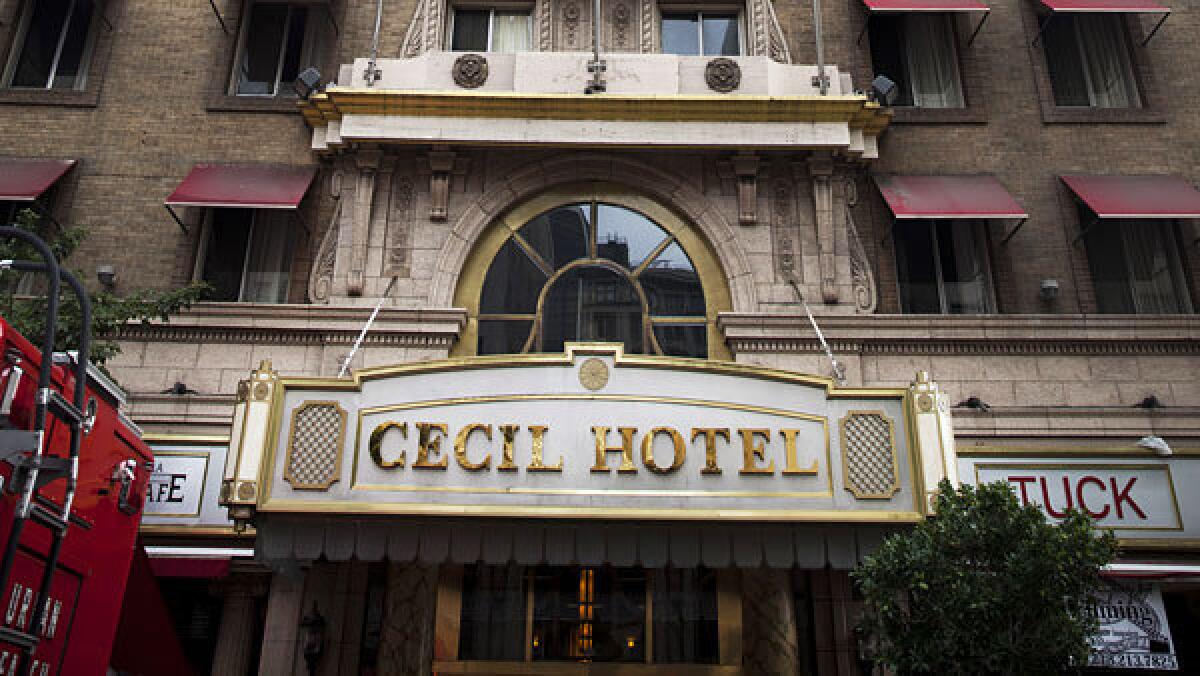Plan to turn Cecil Hotel into homeless housing is withdrawn

- Share via
Turning the Cecil Hotel into homeless housing was supposed to be a quick and innovative way to get skid row residents off the streets.
But a proposal for hundreds of homeless units in the hotel collapsed recently in the face of opposition from downtown business leaders and social service providers, backed by Los Angeles County Supervisor Gloria Molina. They argued the neighborhood is oversaturated with homeless housing and other services.
“Supervisor Molina’s strong opinion is that the skid row area is the way it is because of an over-concentration of services,” Roxane Marquez, Molina’s press deputy, said Friday. “Our goal is to regionalize homeless services.”
The Cecil Hotel project was proposed by the Los Angeles County Department of Health Services and Home For Good — an effort by United Way of Greater Los Angeles and the L.A. Area Chamber of Commerce to end chronic and veteran homelessness by 2016.
The idea was to convert 384 rooms in the historic 15-story building on Main Street, most of which now sit empty, into small efficiencies for homeless people. The Health Services department would manage on-site counseling and mental health treatment to stabilize residents. An additional 75 units would be rented at market rates and 75 more at reduced rates.
Supporters argued the Cecil Hotel project would save taxpayers millions of dollars by providing care for chronically homeless and mentally ill people who otherwise flock to emergency rooms. A similar project in New York City was credited with helping to clear homeless people from the streets around Times Square.
“It would improve the lives of folks who were able to get the units,” said Herb Chase, Cecil Hotel’s managing partner. “It seemed a win-win situation for everybody.”
But skid row is changing, with chic bistros and bars moving into blocks once lined with cardboard boxes and shopping carts.
Opponents of the project said the neighborhood already has thousands of supportive housing units. Homeless people should be scattered throughout the community, they maintain, not clustered on skid row, a hive of substance abusers and drug dealers.
“It’s like having an AA meeting in a bar,” said developer Tom Gilmore, whose residential and retail project at 4th and Main streets helped jump-start the neighborhood’s revival.
“The issue is skid row is a dumping ground for the state of California, the prison system, the mental health system,” Gilmore said. “You could move a thousand people out tomorrow and in two weeks you’d have a thousand more people.
“How can anyone possibly make a balanced community like that?” he asked.
Alice Callaghan, a longtime skid row advocate, said the neighborhood needs more housing for homeless people, even if additional subsidized units are created elsewhere.
Skid row now has “half the housing units we had in 1985,” she said. It’s fine to talk about regionalizing subsidized housing, she added, but if it’s built elsewhere, people in those communities will grab it.
“There are a lot of people in line in Pacoima, in Boyle Heights, to get that housing,” she said, but on skid row, “these are not just low-income people, they’re destitute. You can’t just bus them into another community.”
Chase said he believed the opposition came from property owners with “vested interests on Main Street.”
“Property owners who prefer to have a hotel rather than affordable housing, and they influence decision-makers,” he said.
Countered Gilmore: “Herb Chase is the only person who was going to make money on this deal.”
Patti Berman, president of the downtown neighborhood council, said the area needs a boutique hotel, but it’s not clear that the Cecil’s empty rooms can be used for anything but housing for the poor.
“We have a terrible problem with homelessness not just in Los Angeles but the country,” she said. “That building was not going to solve it. It’s much more complicated than that.”
Though the Health Services department withdrew the Cecil plan while it was still at an early stage, supporters say they haven’t given up on their broader goals of eliminating chronic and veteran homelessness over the next two years.
“It was an opportunity, a way to quickly get a few hundred units on line, probably faster than almost anything we could have done,” said Jerry Neuman, co-chair of Home For Good. “It just means we have to find more opportunities. It doesn’t change our timeline.”
More to Read
Sign up for Essential California
The most important California stories and recommendations in your inbox every morning.
You may occasionally receive promotional content from the Los Angeles Times.










